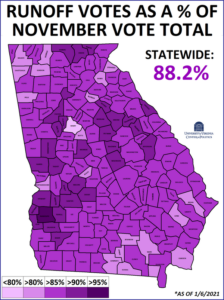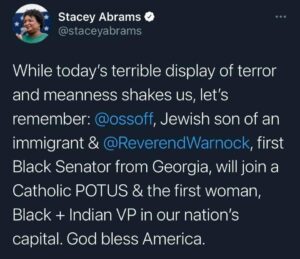Matthew Yglesias explains how “On Day One, Biden Can Start Winning the Midterms” at Blooomberg Opinon: “Job No. 1 (and 2, 3 and 4) is delivering a rapid economic recovery. A big, quick Covid relief bill such as the one Biden unveiled last week would go far toward achieving that, which in turn underscores the need to get something done fast rather than advance ideological pet projects. As negotiations proceed over what and how much to include in this and future relief bills, Democrats should favor easily understandable policies — like sending $1,400 checks to everyone — rather than convoluted and opaque measures…. instead of being coy about it as they were during the 2020 campaign, Democrats should be loud and proud about the fact that the state and local financial assistance they are pledging to deliver in the next relief package is funding the police —and that, by opposing state and local aid, Republicans are in effect defunding the police….Biden cannot afford to settle for a slow recovery. He needs to break 21st century growth records in 2021 in order to position workers for strong wage gains in 2022….Biden also needs to do everything in his power to center the national political agenda on popular progressive ideas such as raising the minimum wage, legalizing marijuana and investing in clean energy. Progressives often tell themselves that this is exactly what they intend to do before getting derailed by things like linking Covid relief to immigration amnesty….For Democrats, the key to success in 2022 is a disciplined agenda in 2021.”
The Des Moines Register editorial Board offers “6 priorities Joe Biden should pursue immediately through executive action to undo the damage done by Trump” including: Restoring Deferred Action for Childhood Arrivals (DACA) program; return the U.S. to the Iran nuclear deal; Reinstate regulations and repair the nation’s framework of environmental protections; Hold for-profit colleges accountable foer their abuses of federal aid programs; and Revoke the gag on health providers, which prevents physicians from making referrals to abortion providers; Shoring up the Affordable Care Act – Trump’s “administration slashed funds to promote Obamacare insurance, shortened the open enrollment period to buy private coverage, welcomed back junk health “plans” that do not cover essential health services, and cleared the way for states to impose work requirements on Medicaid recipients.,,,,We should say goodbye to all of that….The Biden administration can also refuse to allow states to privatize Medicaid programs, which could finally put an end to the costly privatization mess in Iowa, with its record of eroding service and delaying payments to providers.”
At The Hill, Amitai Etzioni urges, “Invoking the War Powers Act (WPA) would enable President Biden to use unique capacities provided in the act to accelerate the vaccination of Americans, without waiting for Congress to confirm his Cabinet members, hold hearings on the needed budget and so on. (The Washington Post reports that “Biden’s incoming administration is in danger of not having a single Cabinet official confirmed on Inauguration Day, upsetting a tradition going back to the Cold War of ensuring the president enters office with at least part of his national security team in place.”)….Drawing on the WPA (as well as on the Defense Production Act, which Biden is already planning to invoke) would allow for rapid, effective, multifaceted domestic mobilization. The statutes enable the president to order corporations that manufacture vaccines to increase their production. If they need additional resources that are not available through the marketplace, the president can order these materials to be turned over to these corporations, compensating those that will be forced to give them up.”
David Roberts aregues that “Joe Biden should do everything at once: How to succeed in hyperpolarized politics: run a blitz” at Vox: “The only thing Biden will have real control over is his administration and what it does. And his North Star, his organizing principle, should be doing as much good on as many fronts as fast as possible. Blitz….Biden’s best chance is to try to overwhelm the system the way Trump did, by doing so much that it’s impossible to make any one thing into a lasting story. He should launch so many simultaneous reforms that there’s no time for right-wing media to make up lies about all of them or for the Supreme Court to hear them all. He should ignore bad-faith attacks and stay relentlessly on message about what’s gotten done and what’s getting done next. He should, at every juncture, get caught trying to make government work better for ordinary people….To succeed, all this must happen alongside Democratic Party efforts to improve messaging and media, get persistent party infrastructure on the ground in communities the party has neglected, and innovate on voter outreach and persuasion. (Aaron Strauss has some good ideas on that front.)”





